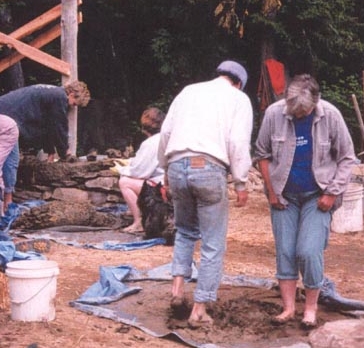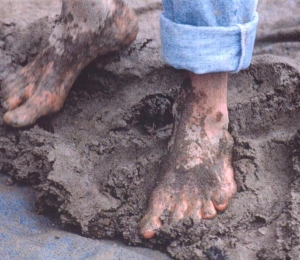Making Cob
Needed Ingredients: a tarp, river sand, clay, straw and water
The clay that we used was from off the site next door which is CCAT new site, the sand was left over from a past Engr project and the straw came from Farm Storm just north of Eureka. It was a conscious choice to obtain the ingredients locally.
When making cob you must first figure out how much sand you need to mix with the clay, tests can be done to figure this out. When I was in Eng 114 last semester we created and tested a few different ratios. We made batches and applied them to the bench and based off of the tests which I have described picked the most sturdy ratio for the materials we have available. The ratio which worked best was, three parts river sand to one part clay some straw and water. When you are building a structure make sure to keep the ratios of each batch of cob consistent. You need to prepare two of the components: the sand, and the clay. Remove any organic matter (such as leaves) from the sand and sifted it. The clay needs to be grated into small enough pieces so that it can be mixed well with water. The clay needs to be wet enough so that it can be mixed into the sand. A good sized batch of cob in regards to mixing is three buckets of sand to one bucket of clay, this sized batch was ideal for about two to four people to mix. Preparation pictures
First put down the tarp, cover it with a thin layer of the sand then put the clay on top of the sand, this stops the clay from sticking to the tarp. Next you do the twist. The best way to mix cob is with your feet. Having music playing for this time intensive part of the cob making can make it quite enjoyable. Every so often pull the tarp over onto itself to mix the ingredients together with this "burrito" technique. The best way to pull the tarp is towards yourself. You can test while you are mixing to make sure that you have enough off all of your ingredients. After the sand is distributed into the clay evenly you can add the straw so that it covers the mixture. It is best to add the straw when the cob is in a "burrito". Then you do the twist again, use the "burrito" technique as much as needed to mix the ingredients. Two more tests can be done to make sure that enough straw has been added.
Finally when the cob is ready the best way to transport it is by making it into balls. These balls also make application easier too.

Mixing
Two people doing the twist
This picture came from cobworks.com

The best mixing tools the feet. This
picture is from cobworks.com